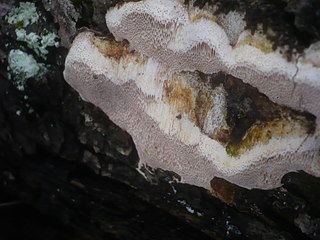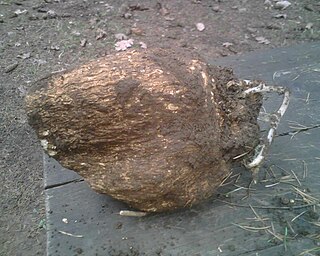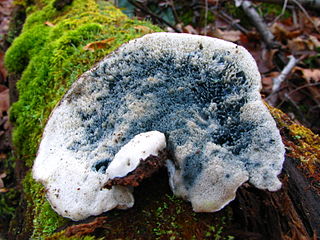
Junghuhnia is a genus of crust fungi in the family Steccherinaceae. It was circumscribed by Czech mycologist August Carl Joseph Corda in 1842. The generic name honours German-Dutch botanist Franz Wilhelm Junghuhn.

The Polyporaceae are a family of poroid fungi belonging to the Basidiomycota. The flesh of their fruit bodies varies from soft to very tough. Most members of this family have their hymenium in vertical pores on the underside of the caps, but some of them have gills or gill-like structures. Many species are brackets, but others have a definite stipe – for example, Polyporus badius.

Perenniporia is a cosmopolitan genus of bracket-forming or crust-like polypores in the family Polyporaceae. They are dimitic or trimitic with smooth, thick-walled basidiospores and cause a white rot in affected wood.

Rigidoporus is a genus of fungi in the family Meripilaceae. Many of the species in this genus are plant pathogens. The widespread genus, which contains about forty species, was originally circumscribed by American mycologist William Alphonso Murrill in 1905. The generic name combines the Latin word rigidus ("rigid") with the Ancient Greek word πόρος ("pore").

Fomitopsis is a genus of more than 40 species of bracket fungi in the family Fomitopsidaceae.

Postia is a genus of brown rot fungi in the family Fomitopsidaceae.

Wolfiporia is a genus of fungi in the family Polyporaceae. The genus was circumscribed by Leif Ryvarden and Robert Lee Gilbertson in 1984 to contain the type species Wolfiporia cocos and W. dilatohypha. The genus is named in honor of mycologist Frederick Adolph Wolf, who was the first to officially describe the type species.

Haploporus is a genus of poroid fungi in the family Polyporaceae.

Antrodia is a genus of fungi in the family Fomitopsidaceae. Antrodia species have fruit bodies that typically resupinate, with the hymenium exposed to the outside; the edges may be turned so as to form narrow brackets. Most species are found in temperate and boreal forests, and cause brown rot.

Ceriporia is a widely distributed genus of crust fungi.

Antrodiella is a genus of fungi in the family Steccherinaceae of the order Polyporales.
Grammothele is a genus of poroid crust fungi in the family Polyporaceae.

Hapalopilus is a genus of poroid fungi in the family Polyporaceae. The genus is widely distributed. The generic name combines the Ancient Greek words ἁπαλός ("tender") and πιλος ("cap"). Hapalopilus was circumscribed by Finnish mycologist Petter Adolf Karsten in 1881.
Megasporoporia is a genus of four species of crust fungi in the family Polyporaceae. The genus is characterized by its large spores, and dextrinoid skeletal hyphae.

Nigroporus is a genus of poroid fungi in the family Steccherinaceae. The genus was circumscribed by American mycologist William Alphonso Murrill in 1905. Nigroporus has a pantropical distribution. The genus name combines the Latin word niger ("black") with the Ancient Greek word πόρος ("pore").

Oligoporus is a genus of fungi in the family Polyporaceae. The genus was circumscribed by German mycologist Julius Oscar Brefeld in 1888 with Oligoporus farinosus as the type. This species is currently known as Postia rennyi. The genus name combines the Ancient Greek words ὀλίγος ("few") and πόρος ("pore").

Pachykytospora is a small genus of poroid fungi in the family Polyporaceae. Species in the cosmopolitan genus cause white rot. There are about 10 species in the genus, with newest member described from European Russia in 2007. Pachykytospora species have fruit bodies that are resupinate, with light brown tubes. They are characterized by their uneven, ellipsoid spores, and the Polyporus-like skeletal-binding hyphae.

Skeletocutis is a genus of about 40 species of poroid fungi in the family Polyporaceae. The genus has a cosmopolitan distribution, although most species are found in the Northern Hemisphere. It causes a white rot in a diverse array of woody substrates, and the fruit bodies grow as a crust on the surface of the decaying wood. Sometimes the edges of the crust are turned outward to form rudimentary bracket-like caps.

Tyromyces is a genus of poroid fungi in the family Polyporaceae. It was circumscribed by mycologist Petter Karsten in 1881. The type species is the widely distributed Tyromyces chioneus, commonly known as the white cheese polypore. The phylogenetic position of Tyromyces within the Polyporales is uncertain, but it appears that it does not belong to the "core polyporoid clade". Tyromyces is polyphyletic as it is currently circumscribed, and has been described as "a dumping place for monomitic white-rot species with thin-walled spores."

Datroniella is a genus of poroid crust fungi in the family Polyporaceae. It was circumscribed in 2014 by Chinese mycologists as a segregate genus from Datronia. Datroniella differs from Datronia by their moderately to frequently branched skeletal hyphae in the context, and absence of dendrohyphidia. The type species of Datroniella is D. scutellata, a fungus originally described as Polyporus scutellatus by Lewis David de Schweinitz. Datroniella fungi cause a white rot, usually on angiosperm wood.


















